
Langley Hall is a red-brick building in the Palladian style, formerly a country house but now a private school, located near Loddon, Norfolk, England. It is a grade I listed building.

Compton is a village and civil parish in the Guildford district of Surrey, England. It is between Godalming and Guildford. It has a medieval church and a close connection to fine art and pottery, being the later life home of artist George Frederic Watts. The parish has considerable woodland and agricultural land, and the undeveloped portions are in the Metropolitan Green Belt. The village is traversed by the North Downs Way and has a large western conservation area. Central to the village are the Watts Gallery, the cemetery chapel commissioned by his wife for him, two inns and the parish church.
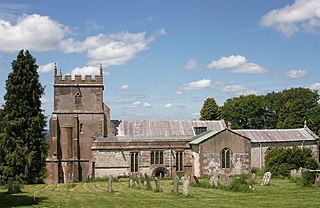
Ashbury is a village and large civil parish at the upper end (west) of the Vale of White Horse. It was part of Berkshire until the 1974 boundary changes transferred it to Oxfordshire. The village is centred 7 miles (11 km) east of Swindon in neighbouring Wiltshire. The parish includes the hamlets of Idstone and Kingstone Winslow. The 2011 Census recorded the parish's population as 506.

Compton Verney is a parish and historic manor in the county of Warwickshire, England. The population taken at the 2011 census was 119. The surviving manor house is the Georgian mansion Compton Verney House.

Madresfield Court is a country house in Malvern, Worcestershire, England. The home of the Lygon family for nearly six centuries, it has never been sold and has passed only by inheritance since the 12th century; a line of unbroken family ownership reputedly exceeded in length in England only by homes owned by the British Royal Family. The present building is largely a Victorian reconstruction, although the origins of the present house are from the 16th century, and the site has been occupied since Anglo-Saxon times. The novelist Evelyn Waugh was a frequent visitor to the house and based the family of Marchmain, who are central to his novel Brideshead Revisited, on the Lygons. Surrounded by a moat, the Court is a Grade I listed building.

Fenny Compton is a village and parish in Warwickshire, England, about eight miles north of Banbury. In the 2001 census the parish had a population of 797, increasing to 808 at the 2011 census. Its name comes from the Anglo-Saxon Fennig Cumbtūn meaning "marshy farmstead in a valley".
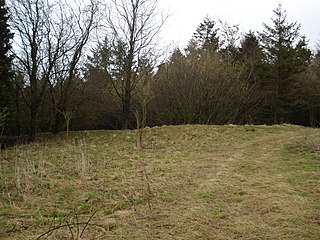
Hardwell Castle or Hardwell Camp is an Iron Age valley fort in the civil parish of Compton Beauchamp in Oxfordshire.

Compton Beauchamp is a hamlet and civil parish 3 miles (5 km) southeast of Shrivenham in the Vale of White Horse, England. It was part of Berkshire until the 1974 boundary changes transferred it to Oxfordshire. The 2001 Census recorded the parish's population as 50.
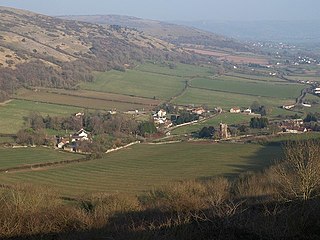
Compton Bishop is a small village and civil parish, at the western end of the Mendip Hills in the English county of Somerset. It is located close to the historic town of Axbridge. Along with the village of Cross and the hamlets of Rackley and Webbington it forms the parish of Compton Bishop and Cross.
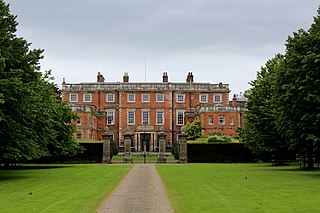
Newby Hall is a country house beside the River Ure in the parish of Skelton-on-Ure in North Yorkshire, England. It is 3 miles (4.8 km) south-east of Ripon and 6 miles (9.7 km) south of Topcliffe Castle, by which the manor of Newby was originally held. A Grade I listed building, the hall contains a collection of furniture and paintings and is surrounded by extensive gardens. Newby Hall is open to the public.

Compton Greenfield is a small hamlet of farms and spread out houses to the south west of Easter Compton, in South Gloucestershire. The parish church of All Saints is a Grade II* listed building. It has a Norman arch in its porch, but the church was largely rebuilt in 1852 in the Neo-Norman style. The churchyard of All Saints is the final resting place of Sir George White founder of the Bristol Aeroplane Company and Sir John Francis Davis, second Governor of Hong Kong.
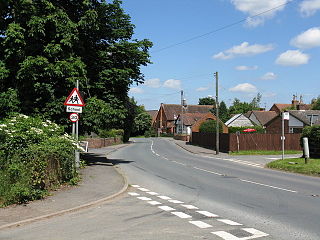
Callow End is a constituent village of the civil parish of Powick in the Malvern Hills District of Worcestershire, England. It is located on the B4424 road about 1 mile (1.6 km) to the south of its junction with the main A449 Malvern to Worcester road. The River Severn runs down the eastern side of the village.

Stoke sub Hamdon Priory is a complex of buildings and ruins which initially formed a 14th-century college for the chantry chapel of St Nicholas, and later was the site of a farm in Stoke-sub-Hamdon, Somerset, England. The only building remaining from the college is a great hall and attached dwelling, dating from the late 15th century. The hall is designated by English Heritage as a Grade I listed building, while the outbuildings and gateway are Grade II listed. The whole site has been scheduled as an ancient monument. A number of the farm buildings are in poor condition, and have been added to the Heritage at Risk Register.
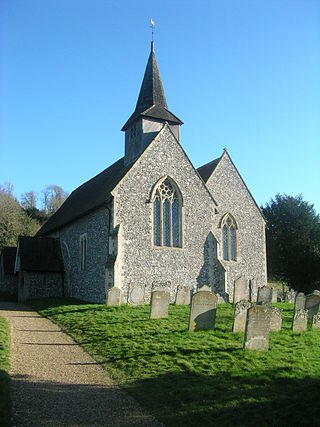
Compton is a village and civil parish in the Chichester district of West Sussex. The village lies on the B2146 road, six miles (9.7 km) southeast of Petersfield, Hampshire and eight miles (13 km) northwest of Chichester. The parish also includes the villages of West Marden and Up Marden.

Shepton Beauchamp is a village and civil parish, 1 mile (2 km) from Barrington and 4 miles (6 km) north east of Ilminster between the Blackdown Hills and the Somerset Levels in the South Somerset district of Somerset, England.

Compton is a former village and today a semi-rural suburb centred 1 mile (1.6 km) ESE of Farnham in the Waverley district of Surrey, England and connected to Farnham by two direct urban single carriageways and green space footpaths along the Wey which in part marks the northern boundary of the area together with the A31. The area relies on Farnham for most of its modern amenities and its eastern part is rural whereas its western part is urban, with a divide where the Wey flows between the two south-eastwards.

Hatch Court in the parish of Hatch Beauchamp, in Somerset, England, is a grade I listed mansion built in about 1755 in the Palladian style with Bath Stone by the wool merchant John Collins to the design of Thomas Prowse. The site had been occupied since the mediaeval era by various forms of the manor house of the manor of Hatch, the caput of an important feudal barony first held by the Anglo-Norman de Beauchamp family in the 11th century.

Wilmington Priory was a Benedictine priory in the civil parish of Long Man, East Sussex, England. The surviving building is now owned by the Landmark Trust and let as holiday accommodation. It is both a Grade I listed building and a scheduled monument.
Cookhill Priory was a Cistercian nunnery near Cookhill in Worcestershire, England.

Greyfriars, Worcester is a Grade I listed building in Worcester, England. Its location near to a former friary of the Franciscan order of Greyfriars has in the past led to speculation that it was constructed as their guest house, but it is now believed to have been built as a house and brew-house c.1485 for Thomas Grene, brewer and High Bailiff of Worcester from 1493-1497. It has been in the ownership of the National Trust since 1966.




















